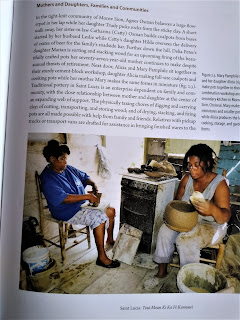I've been reading Creole Clay, by Patricia J. Fay, about functional pottery made in the Caribbean.
There's an active, live tradition, with people making practical pots, mostly for local markets, to make a living. It seems miraculous that such a practice remains real in the modern world. No, it's not the only one, but each such tradition is a holdout, a bit of the pre-industrial world still functioning now. Like the few tribal peoples with whole traditional cultures, this is a marvel and a glimpse of something rare that was once the usual.
American potter Patricia Fay has been living and visiting with potters in Santa Lucia since 1994. The book was published in 2017. So far I have only read the Santa Lucia part of her book. Pots for home use: cooking vessels, dishes, basins, flowerpots, water jars, candle lanterns, and clay cooking stoves (coalpots) are handbuilt by women at home, to meet orders from market sellers and as samples for other markets.
I'm amazed there is a large enough local market to support the level of production. Some of the market is shrinking -- dishes are rarely sold any more, as people buy commercially made ones. Some is expanding, as the potters connect to the tourist trade in souvenirs and hospitality industry products. Still, it works largely as it did traditionally, a domestic market for disposable domestic pots. "the local market continues to support the annual sale of thousands of traditional pottery forms, as well as those clay products adapted and redesigned for foreign visitors. In nearly every house on the island, you'll find a coalpot or two around the back, and a line of flowerpots along the front porch." (p.67)
This is production pottery, like preindustrial workshops, factories without machinery. The ware is standard in design and process, made efficiently, unsigned. New potters are mostly the relatives of current potters, learning at home by helping.
And it is an old process, handbuilt earthenware, fired in bonfires, unglazed.
The pottery production is done at home, part of family life. "The working day... generally runs from about nine in the morning to three or four in the afternoon, with a midday break for cooking, eating and feeding the family. This is the time dedicated to actually making the pots, as opposed to preparing clay, collecting wood and water, or any of the other related tasks." (p.75)
At the same time it is a grand mix of pottery traditions, as the Caribbean is historically a crossroads of ways of life.The local Caribs were potters before Columbus showed up, the incoming Europeans made pottery, the imported west African slaves made pottery at home. Fay traces the shape of the stoves, coalpots, to ancient Greece.
I'm stuck between the good and bad aspects of continuing traditions like this. It seems wonderful, for those of us who value the craft, that people carry on old knowledge and skill, that we can see it happening, and that the potters and the tradition are respected. But it's a very hard life, hard physical work. These potters and their families dig, haul, clean, and hand mix their clay. They coil large pots on boards set on their knees for years. They tend bonfires in the tropics. They carry heavy loads of heavy pots. Yes, they get arthritis.
In Croatia, a few years ago, I found very few studio potters, and heard the explanation that they still remember, and do not value, old ladies in villages hand making pots. They found it all embarrassing, old-fashioned, peasant like. A recently lost tradition, unwanted by people who choose to be modern and forward-looking. In the Caribbean there is a growing studio pottery movement, and wider introduction of kilns and glazes to traditional potters, but no loss of respect for the old way. Sounds great.




